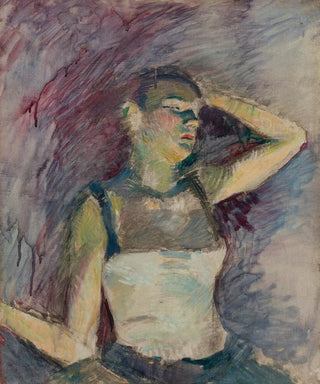Art print | Study of a dancer - Henri de Toulouse-Lautrec


View from behind

Frame (optional)
Henri de Toulouse-Lautrec's "Étude de danseuse" is an invitation to immerse oneself in the vibrant and effervescent world of the Belle Époque. In this piece, the artist manages to capture the grace and energy of a dancer, revealing not only his technical talent but also his deep understanding of the art of movement. Toulouse-Lautrec, with his keen eye, offers us a unique vision of Parisian cabaret shows, where dance and nightlife blend in delicate harmony. This art print of the work allows us to appreciate the intensity of his artistic expression while immersing ourselves in a world where beauty and passion intertwine.
Style and uniqueness of the work
Toulouse-Lautrec's style is distinguished by his ability to combine a realistic representation with a personal interpretation of the subjects. In "Étude de danseuse," the lines are both fluid and dynamic, conveying movement with an almost airy lightness. The colors, often vivid and contrasting, evoke the brilliance of stage lights, while the composition highlights the silhouette of the dancer, almost weightless. This piece reflects the artist's obsession with the body in motion, a fascination he explored through numerous creations. The way he plays with shadows and light, as well as his bold use of angles, gives this study an emotional depth that transcends simple drawing. Thus, each brushstroke seems to breathe life, capturing the fleeting moment of a performance while making it eternal.
The artist and his influence
Henri de Toulouse-Lautrec, born in 1864, is often regarded as one of the pioneers of Post-Impressionism. His artistic career was marked by a deep commitment to the marginalized worlds of his time, notably cabaret artists and dancers. By choosing to depict these often overlooked figures, he not only redefined aesthetic norms of his era but also paved the way for a new form of portraiture, more intimate and authentic. Toulouse-Lautrec was able to capture the essence of

Matte finish

View from behind

Frame (optional)
Henri de Toulouse-Lautrec's "Étude de danseuse" is an invitation to immerse oneself in the vibrant and effervescent world of the Belle Époque. In this piece, the artist manages to capture the grace and energy of a dancer, revealing not only his technical talent but also his deep understanding of the art of movement. Toulouse-Lautrec, with his keen eye, offers us a unique vision of Parisian cabaret shows, where dance and nightlife blend in delicate harmony. This art print of the work allows us to appreciate the intensity of his artistic expression while immersing ourselves in a world where beauty and passion intertwine.
Style and uniqueness of the work
Toulouse-Lautrec's style is distinguished by his ability to combine a realistic representation with a personal interpretation of the subjects. In "Étude de danseuse," the lines are both fluid and dynamic, conveying movement with an almost airy lightness. The colors, often vivid and contrasting, evoke the brilliance of stage lights, while the composition highlights the silhouette of the dancer, almost weightless. This piece reflects the artist's obsession with the body in motion, a fascination he explored through numerous creations. The way he plays with shadows and light, as well as his bold use of angles, gives this study an emotional depth that transcends simple drawing. Thus, each brushstroke seems to breathe life, capturing the fleeting moment of a performance while making it eternal.
The artist and his influence
Henri de Toulouse-Lautrec, born in 1864, is often regarded as one of the pioneers of Post-Impressionism. His artistic career was marked by a deep commitment to the marginalized worlds of his time, notably cabaret artists and dancers. By choosing to depict these often overlooked figures, he not only redefined aesthetic norms of his era but also paved the way for a new form of portraiture, more intimate and authentic. Toulouse-Lautrec was able to capture the essence of






